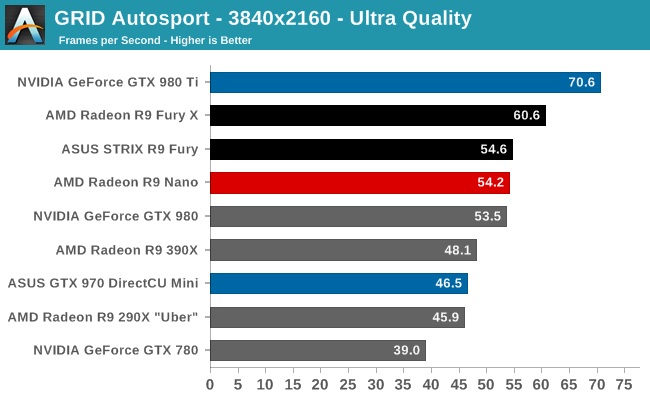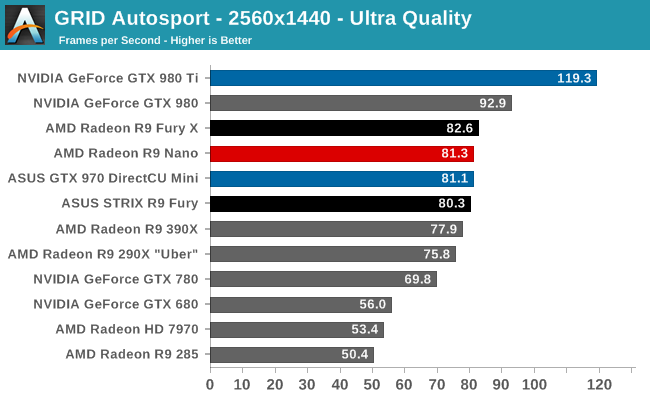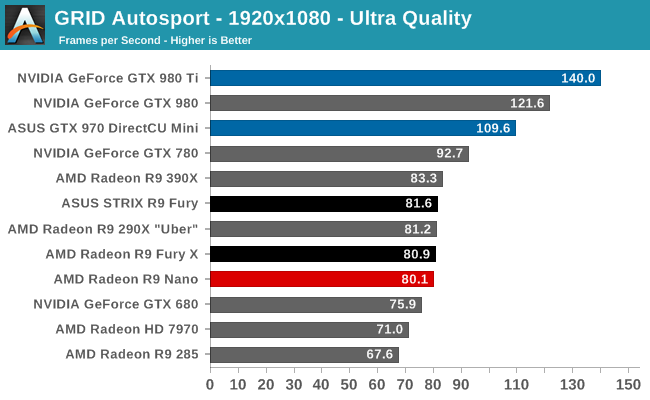The AMD Radeon R9 Nano Review: The Power of Size
by Ryan Smith on September 10, 2015 8:00 AM ESTGRID Autosport
For the racing game in our benchmark suite we have Codemasters’ GRID Autosport. Codemasters continues to set the bar for graphical fidelity in racing games, delivering realistic looking environments layered with additional graphical effects. Based on their in-house EGO engine, GRID Autosport includes a DirectCompute based advanced lighting system in its highest quality settings, which incurs a significant performance penalty on lower-end cards but does a good job of emulating more realistic lighting within the game world.



At 3840x2160 we see the R9 Nano only barely fall behind the R9 Fury, trailing it by less than a percent. Unfortunately R9 Nano can’t quite make 60fps here, which for AMD is limited to the R9 Fury X.
The problem for AMD here is that in lieu of hitting 60fps at 4K, the next best option is to drop down to 2560x1440, at which point AMD’s CPU limitations come into full force, allowing the GTX 980 to leapfrog the entire Fiji family. Ultimately this isn’t anything we haven’t seen before, but it’s a greater problem for a luxury card like the R9 Nano.










284 Comments
View All Comments
Jm09 - Friday, September 11, 2015 - link
Yes I'm aware, but the nano is binned for the highest quality chips. I wish they would of released two models where one was clocked lower and didn't have binned chips. That alone increased the price of this chipMaddyScientist - Thursday, September 10, 2015 - link
It would be nice to use the latest version of LuxMark 3.1, as this has optimizations for both AMD and NVIDIA GPUs, that makes it run faster on more recent GPUs. This would would give a better picture of the compute benefits of these new GPUS.at80eighty - Friday, September 11, 2015 - link
Ryan, i realise it's a test bench, but that cable management is making me twitchy :)Ryan Smith - Friday, September 11, 2015 - link
Noted and agreed. It wasn't really built for public display, it was thrown together for video recording. Small computers are nice, but they're hard to quickly route cables in, especially with my giant hands.awstar - Friday, September 11, 2015 - link
Review > Compute > Vegas: The Vegas benchmark has peaked. The reviewers should post stats on timeline playback performance, or upgrade the test file to 4K XAVC 32-bit float project levels. This would show a much greater difference between the modern GPUs.Haravikk - Friday, September 11, 2015 - link
It's great to see a card like this; finally a proper high end for half-length cards. While there are some good Mini-ITX cases that can take full-length cases, they end up so long that it kind of defeats the point of building small, but half-length cards are usually more in the budget to mid-range bracket, or a generation behind, either way it means a big sacrifice in going small.Hopefully we'll see more competition in this case, as I'm one of those who, in going small, is fine with paying a premium to still remain fairly competitive while doing so.
Regarding the idle noise level though; I still find it weird that there isn't better support out there for switching from integrated to discrete GPUs. Since most people still favour Intel processors this would make a lot of sense given that they have integrated graphics, plus in the Mini-ITX size on the AMD side it can be more cost effective to get an APU anyway. If the integrated GPU could take over for desktop stuff, browsing etc. like we see on laptops, then it would leave the Nano to just function as a set of video interfaces, which would be much better.
Alternatively, I wonder if they could even just add an APU type GPU as a low-power alternative onto the card; i.e- with a light load and low VRAM requirements it would take over and just use some low cost RAM (or even system RAM) so that the rest of the card can be shut off entirely.
Peichen - Friday, September 11, 2015 - link
Modern graphic card only draws single-digit watt power at idle/2D so the whole hybrid GPU idea was dropped. Routing video through integrated GPU also reduce performance by 2-3% and taken into account the complexity involved with driver just to save 8w makes no sense.atomsymbol - Friday, September 11, 2015 - link
R9 Nano: 4096 SP, 1 GHz, 512 GB/s => x+5 FPS, price y+$220R9 390X: 2816 SP, 1.05 GHz, 384 GB/s => x FPS, price y
+35% computational power => +5 FPS
Mathos - Friday, September 11, 2015 - link
After having read this review. All I can really think of to say about the Nano, is they should of priced it at least the same as the regular R9 Fury. That way you'd easily get GTX 980 performance in a itx form factor, for close to the same price. I must say your review seems a bit more fair than Toms hardware. Somehow they had a regular 980 outperforming the FuryX, so I was like wth Toms.I personally had been waiting for the Nano reviews to come out, before deciding what to get. But going by the price, it looks like I'll be getting an R9 Fury, so I can run most games in VSR 1440p, scaled down to 1080p. Either that or I'll just cap my fps at 65 and save power. Should do well once more DX12 games come out too.
itproflorida - Friday, September 11, 2015 - link
you have no idea what your talking about its all speculation. thank you